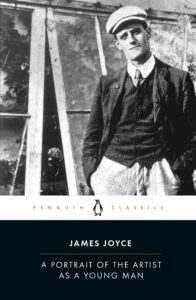
Book Summary
A Portrait of the Artist as a Young Man is a very special book written by James Joyce. It tells the story of a young boy named Stephen Dedalus and his journey to become an artist. This book is full of adventures, dreams, and important lessons that will make you think and feel.
In this book, we get to know Stephen as he grows up and faces many challenges. We see him as a young boy, curious about the world around him. He loves to think and ask questions, just like you! As he gets older, Stephen starts to have big dreams of becoming an artist. He loves to write and express himself through words.
But being an artist is not easy, and Stephen faces many obstacles along the way. He struggles with his family, his school, and even his own thoughts and feelings. Sometimes he feels lost and confused, but he never gives up on his dreams.
A Portrait of the Artist as a Young Man is a book that explores the journey of self-discovery. It shows us that it’s okay to be different and to follow our passions, even if others don’t understand. It teaches us to be brave and to never stop dreaming.
This book is written in a very unique way. James Joyce uses beautiful and poetic language to describe Stephen’s thoughts and feelings. Sometimes it might be a little challenging to understand, but that’s okay! It’s like a puzzle that you can solve with your imagination.
James Joyce was an Irish writer who lived from 1882 to 1941. He is considered one of the most important writers of the 20th century. Joyce wrote many other famous books, but A Portrait of the Artist as a Young Man is one of his most beloved works. He wanted to show the world that art and literature can change lives and make us see the world in a different way.
“A Portrait of the Artist as a Young Man” is a semi-autobiographical novel by James Joyce, first published in 1916. It is a coming-of-age story that chronicles the life of Stephen Dedalus, a young Irishman growing up in late 19th and early 20th century Dublin. The novel is renowned for its innovative narrative style and its exploration of themes such as religion, nationalism, and the pursuit of personal identity and artistic freedom.
“A Portrait of the Artist as a Young Man” is a profound and complex work that delves into the inner workings of a developing artist. The novel is written in a stream-of-consciousness style, a narrative mode that Joyce is famous for, which allows readers to experience Stephen’s thoughts and feelings in a direct, unfiltered way. This style can be challenging but is ultimately rewarding, providing a deep and intimate understanding of the character’s inner life.
The novel is divided into five chapters, each representing a different stage in Stephen’s life. Joyce masterfully captures the evolution of Stephen’s consciousness, from his early childhood experiences to his rebellious adolescence and his eventual decision to leave Ireland and pursue his artistic ambitions.
The book is rich in symbolism and allusion, drawing on a wide range of cultural, historical, and literary references. It is a work that rewards close reading and repeated visits, with each reading revealing new layers of meaning and depth.
“A Portrait of the Artist as a Young Man” is a deeply introspective novel that explores the development of an artistic soul. The protagonist, Stephen Dedalus, is a stand-in for Joyce himself, and through him, Joyce explores themes of religion, nationalism, and the role of the artist.
Religion plays a significant role in the novel, reflecting Joyce’s own complicated relationship with the Catholic Church. Stephen’s struggle with his religious beliefs, particularly in the face of the guilt and fear instilled in him by his Catholic upbringing, is a central theme of the novel.
The novel also explores the theme of nationalism. Stephen’s rejection of Irish nationalism in favor of artistic freedom reflects Joyce’s own views on the subject. The novel suggests that true freedom, for an artist, lies in the ability to transcend national and cultural boundaries.
Finally, the novel is a profound exploration of the nature of art and the role of the artist. Stephen’s decision to leave Ireland and dedicate himself to the creation of art reflects Joyce’s belief in the importance of artistic freedom and the artist’s duty to remain true to their vision, regardless of societal pressures.
James Joyce (1882-1941) was an Irish novelist, short story writer, and poet, considered one of the most influential writers in the modernist avant-garde of the early 20th century. His other works include “Ulysses,” “Finnegans Wake,” and the short story collection “Dubliners.” Joyce’s innovative narrative techniques, including the extensive use of stream-of-consciousness, have had a profound influence on the development of 20th-century literature. Despite the complexity of his works, Joyce’s deep exploration of human consciousness and his masterful use of language have earned him a place among the most celebrated writers of all time.
Don Quixote by Miguel de Cervantes
Miguel de Cervantes
Read Now →